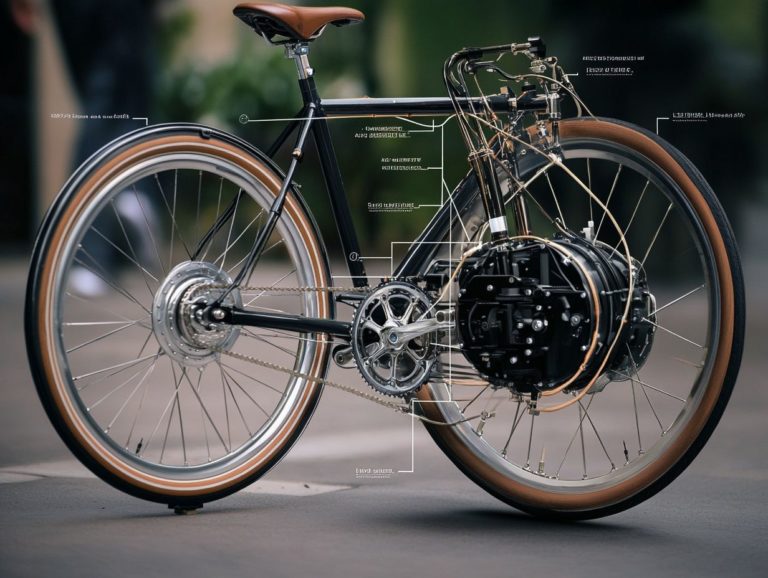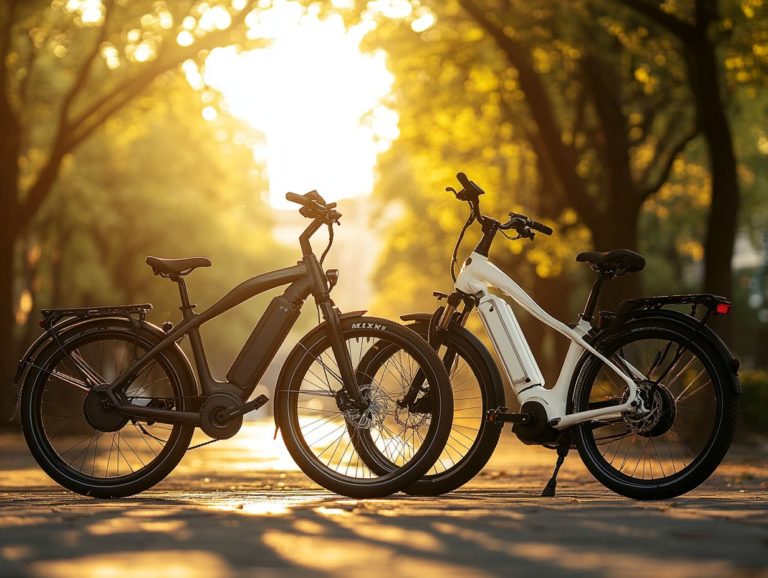A Guide to Electric Bicycle Weight Considerations
Choosing the right electric bicycle is about more than just aesthetics and features; the weight of the bike significantly influences your riding experience.
This article delves into the elements that contribute to the weight of electric bikes, highlighting the benefits of opting for lighter models. You’ll also find essential factors tailored to your specific needs.
Whether you’re maneuvering through challenging terrain or seeking to elevate your performance, you ll uncover practical tips for reducing weight without compromising quality.
Get ready to discover how a lighter bike can transform your ride, especially in urban settings and commuting scenarios!
Contents
- Key Takeaways:
- Understanding Electric Bicycle Weight
- Benefits of a Lighter Electric Bicycle
- Factors to Consider When Choosing Weight
- How to Reduce the Weight of an Electric Bicycle
- Frequently Asked Questions
- What is the average weight of an electric bicycle?
- Does the weight of an electric bicycle affect its performance?
- What is the maximum weight capacity for an electric bicycle?
- How does the weight of the battery affect the overall weight of an electric bicycle?
- Are there any advantages to having a lighter electric bicycle?
- Can the weight of an electric bicycle be reduced?
Key Takeaways:

- Lighter electric bicycles offer improved performance and maneuverability, enhancing adaptability in various environments.
- When choosing a bike, consider rider weight, terrain, battery capacity, and range.
- To reduce weight, use lighter materials, remove unnecessary accessories, and choose a smaller battery.
Understanding Electric Bicycle Weight
Grasping the importance of electric bicycle weight is essential when choosing the perfect e-bike for your commuting needs, particularly if you are considering more robust e-bikes. Several factors play a role in an electric bicycle’s weight, including the frame material be it aluminum or carbon fiber and the types of components utilized, both of which can impact performance and durability.
Understanding weight limits ensures safety and efficiency, especially in urban environments where maneuverability is paramount. An electric bicycle’s weight affects its portability significantly and your overall cycling experience, especially when exploring the essential guide to electric bicycle components and the lightest electric options available.
What Contributes to the Weight?
The weight of your electric bike is shaped by several key factors, including the frame material, motor type such as hub motors or mid-drive motors and battery capacity.
Consider the choice between aluminum and carbon fiber; it s more than just a matter of preference. Aluminum frames are typically robust and budget-friendly, while carbon fiber presents a lightweight, high-performance alternative that significantly enhances handling.
The type of motor you choose also plays a crucial role. Whether you opt for a hub motor integrated into the wheel or a mid-drive motor positioned near the pedals, the impact on weight distribution can be dramatic. Hub motors might lead to a heavier front or rear end, whereas mid-drive systems tend to offer a more balanced center of gravity, which ultimately influences your riding experience and efficiency. For a deeper understanding of these options, check out a comprehensive guide to electric bike features.
Don’t overlook battery capacity, either. It contributes to the overall weight and has a direct effect on your bike’s performance and range. For those new to electric bikes, checking an electric bicycle buying guide for beginners can provide valuable insights.
Benefits of a Lighter Electric Bicycle
A lighter electric bicycle presents a wealth of benefits that significantly enrich your cycling experience, particularly when it comes to urban commuting. With a lightweight electric bike, you’ll enjoy improved performance, making it easier for you to handle and navigate through traffic with agility.
Enhanced portability is another noteworthy advantage; these lighter models are not only easier to transport but also more convenient to store. Furthermore, their lightweight designs often translate into better climbing ability, increased comfort, and overall stability, all of which contribute to a more enjoyable ride, especially when you encounter challenging terrains.
Improved Performance and Maneuverability

Lightweight electric bicycles elevate your performance and maneuverability. They are the perfect companion for urban commuting.
The reduced weight of these bicycles translates into enhanced grip and stability—essential qualities for navigating bustling streets filled with obstacles and unpredictable terrain. As you glide over potholes or weave through crowded pedestrian areas, the agile design of lightweight electric bicycles enables swift turns and quick responses. However, it’s important to consider weight limits for electric bicycles to ensure your safety and confidence.
This remarkable balance ensures a more comfortable riding experience and enhances overall performance, allowing you to maintain higher speeds with less effort. Those who frequently tackle city commutes can transform their daily ride from a mundane task into an exhilarating adventure.
Factors to Consider When Choosing Weight
When selecting an electric bicycle, consider several key factors related to weight to guarantee optimal performance and safety.
Weight limits are especially important for electric cargo bikes. They determine how well the bike can accommodate your weight and any additional cargo, directly affecting your overall cycling range and experience.
The terrain you’ll navigate also plays a significant role. Different weights can influence riding comfort and climbing capability across various surfaces.
Rider’s Weight and Terrain
A rider’s weight significantly impacts the performance and stability of an electric bicycle, especially across varied terrains.
When tackling steep hills or navigating rough trails, weight distribution becomes essential for how well the e-bike handles. Heavier riders often benefit from increased traction and stability during downhill descents, enhancing their confidence and control. To make the best choice, consider the top factors to consider when buying an e-bike.
Lighter riders may find it easier to accelerate and maneuver through tight corners. It’s also crucial to consider tire pressure and frame geometry, as the shape and design of the bike frame can significantly affect the overall performance. Additionally, if you’re curious about how much electric bicycles weigh, understanding these nuances can help you fine-tune your bike setup for ultimate enjoyment, ensuring a smoother cycling experience.
Battery Capacity and Range
Battery capacity is a crucial element that directly influences the cycling range of electric bicycles. It is closely tied to weight limits and overall performance, especially in urban commuting.
A higher battery capacity allows you to embark on longer journeys without the worry of needing to recharge. This is especially advantageous for extended commutes or leisurely weekend rides.
However, remember that the weight of the rider and any extra cargo can affect battery efficiency. When heavier loads come into play, your electric bike will need more power to maintain speed and tackle hills, which can ultimately shorten your range.
Understanding the relationship between battery capacity and weight limits is essential for any rider looking to enhance their cycling experience while ensuring they have enough energy to reach their destinations comfortably.
How to Reduce the Weight of an Electric Bicycle

Reducing the weight of your electric bicycle can greatly enhance its performance and ease of use, especially for urban commuting.
Selecting lightweight electric bike kits or conversion kits designed to minimize added weight can be effective. Using high-quality, lightweight materials for any extra components contributes to a sleeker, more efficient design overall.
Get ready to transform your ride! Explore the possibilities of lightweight biking today!
Tips and Tricks for Lightening the Load
To lighten your electric bicycle, consider some practical tips that enhance both performance and portability.
Focusing on materials and components like lightweight frames and high-efficiency batteries can significantly reduce overall weight, ensuring better performance during your ride. For example, choosing carbon fiber or aluminum frames decreases heft while boosting speed and handling. Upgrading to a lithium-ion battery, known for its lightweight and efficiency, enhances the overall comfort of your ride. Additionally, understanding the impact of weight on electric bicycle performance can further optimize your riding experience.
Using compact tires can improve agility without compromising grip. Each of these strategies makes maneuvering easier and ensures that your cycling experience remains enjoyable, especially when using Fucare bikes for extended journeys.
Frequently Asked Questions
What is the average weight of an electric bicycle?
Wondering how heavy an electric bicycle is? It’s usually between 45-60 pounds, depending on the size, materials, and battery specifications, which can vary across different models such as city bikes and traditional bicycles.
Does the weight of an electric bicycle affect its performance?

Yes, the weight of an electric bicycle can affect its performance. Heavier electric bicycles may have slower acceleration and require more effort to pedal compared to lighter ones, making lightweight electric bicycles a better choice for urban commuting.
What is the maximum weight capacity for an electric bicycle?
The maximum weight capacity for electric bicycles can vary, but on average, it is around 250-300 pounds. It’s important to check the manufacturer’s specifications for the exact weight limit, especially if you’re considering a heavy-duty e-bike.
How does the weight of the battery affect the overall weight of an electric bicycle?
The weight of the battery can significantly affect the overall weight of an electric bicycle, especially in designs that prioritize portability and efficiency. Larger batteries with higher capacities tend to be heavier, adding extra weight to the bike.
Are there any advantages to having a lighter electric bicycle?
Yes, lighter electric bicycles have several advantages. They are easier to handle and maneuver, require less effort to pedal, and can have a longer range because they use less energy. Don’t miss out on the benefits of a lightweight electric bicycle!
Can the weight of an electric bicycle be reduced?
Yes, the weight of an electric bicycle can be reduced by choosing lighter materials, opting for a smaller battery, or removing unnecessary accessories. However, consider the impact of weight on the bike’s performance before making any changes.






